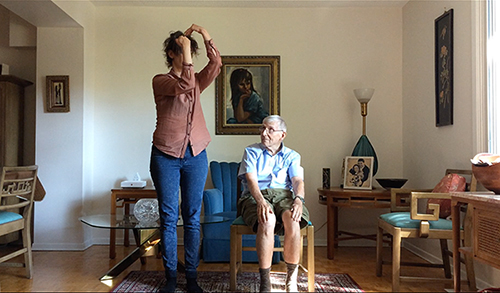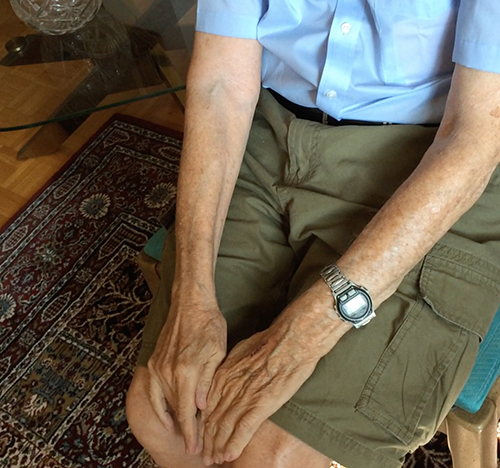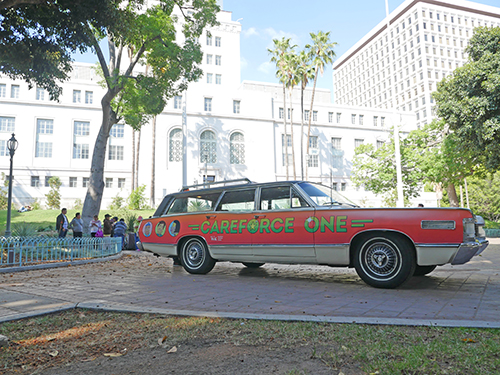
Take Care
Curated by Letters & Handshakes
September 11, 2017–March 10, 2018
Download the Circuit 2 micropublication featuring project descriptions, a curatorial essay for The Let Down Reflex by Amber Berson and Juliana Driever, artist biographies, and full colour illustrations throughout.

Work is a primary scene of the crisis of care. Take Care’s second circuit, Care Work, confronts the systemic undervaluing of caring labour by a capitalist political economy whose living foundation is nonetheless maintained by this labour. The work of care is unbound, yet it tends to be associated with private spaces and enclosed institutions. Making care public, Care Work renders the performance of care visible, audible, and haptic. Continuing Take Care’s effort to name care gaps within art institutions, Care Work centres the position of cultural workers with caring responsibilities for children, elders, communities, languages, land, and water. Traversing this circuit are multiple formations of care work: cultural formations—circulating visual communication strategies to counter gendered and racialized stereotypes of the figure of the caregiver; political formations—tracking transnational movements of care work and profiling practices of solidarity within local communities; technological formations—probing the power relations that course through care’s machinization; and corporeal formations—choreographing the affective rhythms and recompositional possibilities of care work. Expanding what counts as the work of care, Care Work responds to the extractivist attitude that care is perpetually available for the taking, a point on which the crises of care and ecology converge, with the proposition that attending to the work of care is integral to a transformational project to reframe “care as infrastructure.” [1]
[1] Letters & Handshakes, “Care as Infrastructure: An Interview with Ai-jen Poo,” The Blackwood 1 (July 2017): 6-7.

k.g. Guttman
Hands become Ears, 2017
Artist-in-Residence in Student Residence, October 16–November 4
Performances: October 25–November 4
A collaboration with Terrill Maguire, Coman Poon, and Rosemary (Rosie) Horsley, Audrey Joyal, Carol Lim, Diane Milliard, Lynn Shaw, and Lorna Williams, Hands become Ears is a two-part performance, commissioned by the Blackwood Gallery, exploring “affective virtuosity” [1] in site-specific encounters. The performance cultivates techniques of talking, listening, moving, smelling, tasting, and touching in order to probe the space between performer and audience. Guttman considers attention to be a combination of all bodily senses—a participation of the senses in each other.
In Part I, invited seniors accompany a student audience member on a walk through the University of Toronto Mississauga campus. This gesture unites the hospitality of two strangers meeting, and the rhythm of walking with the exchange of personal narrative, memory, and conversation. The student audience member is then dropped off at the door of a campus residence, and Part II begins: a private indoor performance that accelerates and enhances the everyday tempo of things.
Intertwining modes of performance in private and public sites, Hands become Ears collapses the everyday gesture and the choreographed encounter to situate social codes of engagement within unfamiliar circumstances. Guttman asks of her audience a small surrender of autonomy in order to attune to an ethics and poetics of interdependence, in which care involves fluctuating exchanges of power that are continually renegotiated.
Presented in collaboration with students in Sociology 352: Gender and Care, taught by Alexandra Rodney and designed by Cynthia Cranford.
[1] “[A]ffective virtuosity: this is a matter of a criterion of social ecology, which breaks with the idea that care happens because someone loves you and presents it more as an ethical element that mediates every relation.” Precarias a la Deriva, “A Very Careful Strike – Four Hypotheses,” trans. Franco Ingrassia and Nate Holdren, in The Commoner, no. 11 (2006): 40.

Marisa Morán Jahn (Studio REV-)
CareForce
CareForce is a transmedia public art project, mobile studio, and web-series amplifying the voices of America’s fastest-growing workforce–caregivers.
For the past six years, Morán Jahn has collaboratively developed work with caregivers and care-receivers to produce know-your-rights tools, an episodic film, and artworks that dignify care work. Produced in partnership with a dozen grassroots organizations, these works have reached over 20,000 workers and employers on the ground and millions more through international media presence.
A new work commissioned by the Blackwood Gallery, Choreography of Carework explores how care work involves remarkable bodily labour and often-repetitive motion, yet in many jurisdictions care workers are excluded from the labour protections available to other workers. Choreography of Carework chronicles Morán Jahn’s collaboration with domestic workers to choreograph a dance whose booty-shaking gestures narrate the movement for domestic workers’ rights, joyfully reclaiming the caring body as one that has been historically proscribed from US labour law, and insisting on the visibility of undocumented care workers and care work writ large. Through personal reflection and interviews with Vero Ramirez, Guillermina Castellanos, and Marcia Olivo, Choreography of Carework generates unlikely connections between ergonomics, domestic labour, immigration, and the politics of space.
Since 2013, Morán Jahn has been recording songs sung by domestic workers that she meets while travelling in her custom-designed jalopies, the NannyVan and CareForce One. In 2017, Morán Jahn gave Diana Nucera (a.k.a. Mother Cyborg) her recordings of caregivers singing hymn and labour-movement song “Amazing Grace,” for her to remix into electronic dance music. For Take Care, Morán Jahn will use this song in a collaboration with care workers to choreograph a dance inspired by the global diaspora of domestic workers.

Kwentong Bayan Collective
In Love and Struggle, 2017
In Love and Struggle: A Visual Timeline of Caregiving Work in Canada (2017) examines the history of care work performed by Indigenous and racialized women in Canada. The timeline intervenes in conversations about Canada 150 celebrations by encouraging a critical examination of history in support of struggles for radical change. Caregivers have made invaluable contributions to Canada’s social, economic, and political history, yet they have consistently had to fight for their labour to be respected and recognized, and won shifts to justice and equity rooted in caregivers’ perseverance and resistance as a community.
The 90’s: Philippine National Day, Seaton Park (2014) is drawn from a comic book that Kwentong Bayan Collective is currently developing. This project, Kwentong Bayan: Labour of Love, involves collaboration with caregivers, advocates, and community allies about the real-life stories of Filipinx migrant caregivers working in Canada under the federal government’s Caregiver Program

Onaman Collective
Land and Water Projectors, 2016–2017
Onaman Collective is an Indigenous, grassroots, land-based art initiative founded by Michif artist Christi Belcourt, Michif artist Erin Marie Konsmo, and Anishinaabe artist Isaac Murdoch to share traditional knowledge and language with youth. On the name of the collective, Sâkihitowin Awâsis writes: “Onaman is the name of the red ochre paint used by Anishinaabek, Nehiyawak, and Michif peoples. It is also used as a clotting agent for wounds in traditional medicine–a telling metaphor for the intergenerational healing associated with the land-based knowledge and language revitalization cultivated by the collective’s wide-ranging creative projects and community collaborations.” [1]
With the belief that the arts are the most powerful medium to create positive social change within communities, collective artists Belcourt and Murdoch have been making banner images freely available for land and water protectors and organizers to use for land or water protection actions. [2] Thunderbird Woman, a recurring figure in the banners, has appeared on the frontlines of Standing Rock, on the edges of the Alberta Tar Sands, at a rally against Enbridge Line 5 pipeline along Highway 17 near Espanola, Ontario, and on the lawn of the Supreme Court in Ottawa.
Presented alongside the banners in the Blackwood Gallery are three videos by Onaman Collective that form part of #Resistance150, a project “intended to highlight the many ways Indigenous peoples have historically resisted, and continue to resist, what many see as discriminatory and assimilationist policies of the Canadian government, such as those regarding pipeline construction, access to drinking water, and child welfare funding gaps. Perhaps most importantly, the Indian Act itself."[3]
NOTES
[1] Sâkihitowin Awâsis, “Keep it in the Ground!,” Canadian Art (Summer 2017), 63.
[2] Onaman Collective, Banner Images for Land and Water Protectors, 2017. Banner downloads are available here: http://onamancollective.com/murdoch-belcourt-banner-downloads/
[3] Alicia Elliot, “#Resistance150: Christi Belcourt on Indigenous History, Resilience and Resurgence,” CBC (February 22, 2017): http://www.cbc.ca/2017/resistance150-christi-belcourt-on-indigenous-history-resilience-and-resurgence-1.3992226
The Let Down Reflex
Curated by Amber Berson and Juliana Driever
Lise Haller Baggesen and Deirdre M. Donoghue, Cevan Castle / The Center for Parenting Artists, Dillon de Give, Home Affairs with Ozlem Ozkal, Leisure, LoVid, Jacqueline Hoàng Nguyễn, Shani K Parsons, Kerri-Lynn Reeves, Shane Aslan Selzer
October 16–November 4, 2017
FREE Contemporary Art Bus Tour
Sunday, October 15, 12–5pm
The tour picks up at Gladstone Hotel (1214 Queen Street West) then departs for Blackwood Gallery, Art Gallery of Mississauga, Art Gallery of York University, and Y+ contemporary. To RSVP: email blackwood.gallery@utoronto.ca or call 905-828-3789 by Friday, October 13 at 5pm.
Carework as Choreography
Wednesday, October 18, 12–4pm
12–2pm: Feminist Lunchtime Talks with CareForce (Marisa Morán Jahn), Cynthia Cranford, Kwentong Bayan Collective (Althea Balmes and Jo SiMalaya Alcampo), Pinky Paglingayen (TNO Caregivers in Transition Program)
2–3pm: Exhibition Talk & Tour
3pm: Dance Rally
Blackwood Gallery
The Feminist Lunchtime Talks are presented in partnership with Women and Gender Studies (UTM).
Care, Automated
Workshop with Amelia Abreu, Marc Böhlen, Hermenio Lima, Ian Roderick, Sarah Sharma, David Harris Smith, Frauke Zeller
Hosted by Letters & Handshakes
Saturday, October 21, 11am–3pm
McLuhan Centre for Culture and Technology, 39 Queen’s Park Cres. E., Toronto
Workshop presented in partnership with and funded by the McLuhan Centre for Culture and Technology, Faculty of Information, University of Toronto.
Reader-in-Residence Session with Art Metropole
Public reading by Alize Zorlutuna
Wednesday, October 25, 12–1pm
Blackwood Gallery
Hands become Ears
Performances led by k.g. Guttman
In collaboration Terrill Maguire, Coman Poon, and local seniors
For students, by appointment only
October 25–November 4 (not including Sundays)
University of Toronto Mississauga campus
Love’s Labours
A moving image program curated by Shani K Parsons
Saturday, October 28, 1–3pm
The Revue Cinema, 400 Roncesvalles Avenue, Toronto
FREE Screening. Please RSVP to reserve your seat.
A Day of Affectionate Actions
Saturday, November 4, 1–4pm
1pm: Introduction by Amber Berson and Juliana Driever
1:30pm: HouseHold by LoVid
3pm: By My Own Admission by Dillon de Give
MiST Theatre, UTM
For more information on Love's Labours and A Day of Affectionate Actions, visit The Let Down Reflex exhibition webpage.
Lise Haller Baggesen studied painting at the AKI in Enschede, the Rijksakademie in Amsterdam and completed her MA in Visual and Critical Studies at the School of the Art Institute of Chicago. She has exhibited her work internationally, is the author of Mothernism (2014), and the co-organizer of The Mothernists in Rotterdam (2015) and The Mothernists 2: Who Cares for the 21st Century at Astrid Noack’s Atelier and at the Royal Academy for Fine Art, Copenhagen (2017).
Amber Berson is a writer, curator, and PhD student conducting doctoral research at Queen’s University on artist-run culture and feminist, utopian thinking. She most recently curated The Let Down Reflex (with Juliana Driever) and was the 2016 curator-in-residence as part of the France-Quebec Cross-Residencies program at Astérides in Marseille, France. She is the Canadian ambassador for the Art+Feminism Wikipedia project.
Artist-engineer Marc Böhlen (a.k.a. RealTechSupport) imagines and designs information systems that reflect on automation as cultural currency. Böhlen is Professor of Media Study at the University at Buffalo and is co-creator of the online resource “Robots for Last Days.” His projects query the relationship between people and automation at large, generating unexpected qualities from quantitative processes.
Cevan Castle, founder of The Center for Parenting Artists, is an architectural designer, artist, and principal of a firm working in urban landscape and exterior architecture. Castle teaches professional practices in art and design, as well as pre-kindergarten and early childhood education. She holds a Master’s of Architecture from Columbia University (New York) and a BFA from the College for Creative Studies (Detroit).
Cynthia Cranford is an Associate Professor of Sociology at the University of Toronto Mississauga, where she leads the research project “Understanding and Im- proving Immigrant Labour Markets for Personal Care Work: A Comparative Analysis of Public Sector Personal Care Work in North America.” She is currently writing a book comparing personal care in California and Ontario from the vantage points of workers, service users, labour and disability activists, employers, and state officials.
Deirdre M. Donoghue lives and works in Rotterdam. She is a performance and visual artist, mother, doula, founding director of the international m/other voices foundation for Art, Research and Theory / Dialogue / Community Involvement, PhD candidate at the Institute for Cultural Inquiry, University of Utrecht, and a founding member of ADA: Area for Debate and Art, Rotterdam.
Juliana Driever is a curator and writer focused on collaborative practices, public space, and site-specificity. Recent curatorial work includes The Let Down Reflex (2016, with Amber Berson, EFA Project Space, New York), Socially Acceptable (2015, Residency Unlimited/InCube Arts), Art in Odd Places 2014: FREE (with Dylan Gauthier, New York), and About, With & For (2013, Boston Center for the Arts).
Dillon de Give is an artist and educator working with performance, film, publication and documentary forms. He is a co-founder of the Walk Exchange, a cooperative walking group, and organizes the annual Coyote Itinerancy, a retreat that traces a foot- path between New York City and the wild.
k.g. Guttman is an artist, educator, and research candidate in the PhD Arts program of Leiden University and the Royal Academy of Art in the Hague, the Netherlands. Her work considers how territoriality and choreography are intertwined in site-specific practices and has been shown in performances, exhibitions, residencies, and commissions throughout Canada, the United States, Mexico, and Europe.
Founded by Arzu Ozkal, Claudia Pederson, and Nanette Yannuzzi, HOME AFFAIRS is an interdisciplinary art collective focusing on creative projects about a range of issues impacting women’s lives. The group has exhibited and performed at diverse venues including Spaces Gallery (Cleveland), EFA Project Space (New York), Project Goleb (Amsterdam), and Art Produce Gallery (San Diego).
An artist and transmedia producer of Ecuadorian and Chinese descent, Marisa Morán Jahn founded Studio REV-, a non-profit organization whose key projects include El Bibliobandido, Video Slink Uganda, Contrat- ados, the Nannyvan, an app for domestic workers that CNN named as “one of 5 apps to change the world,” and the CareForce. She is a graduate of MIT and teaches at MIT, Columbia University, and The New School.
Kwentong Bayan Collective is a collective of two Toronto-based artists, Althea Balmes and Jo SiMalaya Alcampo. Their work explores critical and intersectional approaches to community-based art, labour, and education. They are currently developing a comic book, Kwentong Bayan: Labour of Love, in close collaboration with caregivers, advocates, and community allies about the real life stories of Filipinx migrant care-givers working in Canada under the Care-giver Program (formerly known as the Live-in Caregiver Program).
Leisure is the Montreal-based conceptual collaborative art practice of Meredith Carruthers and Susannah Wesley. Working together under the name “Leisure” since 2004, they engage with cultural-historical narratives through research, conversation, published texts, curatorial projects, and art production. Leisure exhibits regularly at Erin Stump Projects (Toronto) and has work in the permanent collection of the Leonard & Bina Ellen Art Gallery (Montreal).
Letters & Handshakes is a collaboration of Greig de Peuter (Department of Com-munication Studies, Wilfrid Laurier University) and Christine Shaw (Blackwood Gallery and Department of Visual Studies, University of Toronto Mississauga).
LoVid is a New York-based artist duo comprised of Tali Hinkis and Kyle Lapidus. LoVid’s work includes immersive installations, sculptural synthesizers, single channel videos, textiles, participatory projects, mobile media cinema, works on paper, and A/V performance. Collaborating since 2001, LoVid has performed and presented works at venues throughout the United States, Europe, and the Middle East.
Award-winning choreographer Terrill Maguire has had an extensive and wide-ranging career in dance and related arts. Her creation and performance life has been located in her native California, in New York, Toronto, and Ottawa; she has also danced in London England, Ireland, and Paris, France. Her work has been presented in theatres large and small, on television and in film; in trees and forests; in fountains, galleries, city streets and historical sites, among other places.
Jacqueline Hoàng Nguyễn is a research-based artist based in Stockholm. Using a broad range of mediums, her artistic practice investigates issues of historicity, collectivity, utopian politics, and multiculturalism within the framework of feminist theories. Nguyễn is the 2017 Audain Visual Artist in Residence at Simon Fraser University in Vancouver and will participate in the fourth cycle of NTU Center for Contemporary Art Singapore’s Residencies program.
Onaman Collective is a community-based social arts and justice organization founded in 2014 by Christi Belcourt, Isaac Murdoch, and Erin Konsmo. Onaman Collective is interested in helping Indigenous communities, particularly youth, with reclaiming the richness and vibrancy of their heritage. The collective combines land-based con- temporary art with traditional arts, anishnaabemowin immersion, and Elders’ and traditional knowledge.
Pinky Paglingayen is a former caregiver and is currently a Settlement Counsellor with the Caregivers in Transition program at Thorncliffe Neighbourhood Office.
Shani K Parsons is an independent curator, designer, and founding director of Critical Distance Centre for Curators (CDCC) in Toronto. With degrees in architecture (Temple University) and design (Rhode Island School of Design) she has pursued a trans- disciplinary practice within independent and institutional contexts such as the American Museum of Natural History, Museum of Chinese in America, Museum of Modern Art, and Mixed Greens (New York).
Coman Poon is a Toronto-based interdisciplinary artist, activist, curator and producer working within contexts of decolonization and intercultural exchange. He actively collaborates with artists, social and environmental justice activists, academics, filmmakers, photographers, video and sound technicians, poets and writers, architects and builders to realize his diverse local and transnational initiatives.
Kerri-Lynn Reeves is a Canadian arts labourer working as an artist, writer, educator, curator, and administrator. She holds a BFA from the University of Manitoba and a MFA from Concordia University in Fibres and Material Practices. Her work explores the relationship of the social and the material, especially as it relates to the construction of social space, the marking of physical place, and the activation of embodied site.
Ian Roderick is an Associate Professor in the Department of Communication Studies at Wilfrid Laurier University. He is the Special Issues Editor for Critical Discourse Studies and recently published Critical Discourse Studies and Technology: A Multimodal Approach to Analysing Technoculture (2016). His research interests include technology and culture, militarism, and critical dis- course studies.
Shane Aslan Selzer is an artist, writer, and organizer whose practice develops micro- communities where artists can expand on larger social issues such as exchange, critique, and failure. Selzer is a founding member and Co-Director of Global Crit Clinic, an international peer learning network for artists working to diversify the field by sharing tools for participation.
Sarah Sharma is Associate Professor of Media Theory at the Institute of Communication, Culture, Information and Technology and Director of the McLuhan Centre for Culture and Technology at the University of Toronto. She is the author of In the Meantime: Temporality and Cultural Politics (Duke University Press, 2014) and is currently working on a new book that explores the gendered politics of exit and refusal, or what she terms the “(s)Exit” within contemporary techno-culture.
Born in Toronto, Boo Watson began playing and composing music at the age of five, and played in bands for over three decades. In the 1970s she joined the Wages for Housework Campaign and co-founded Wages Due Lesbians. She wrote songs for the movement, many of which were published in Wages for Housework International’s Conference Song Book (1975). She is now the owner of a hundred-acre art farm, producing organic food, music, theatre, and other arts in Manitoulin Island, Ontario.
Alize Zorlutuna works with installation, video, performance, and material culture. Her work investigates themes concerning identity, queer sexuality, settler-colonial relationships to land, culture and history, intimacy with the non-human, and technology. She received her MFA from Simon Frasier University and currently teaches courses in contemporary sculpture, installation, performance, and hybrid media practices at OCADU in Toronto.
The Blackwood Gallery gratefully acknowledges the operating support of the Canada Council for the Arts, the Ontario Arts Council, and the University of Toronto Mississauga.

The Blackwood Gallery is grateful for additional support for Circuit 2: Care Work from the Department of Visual Studies (UTM); McLuhan Centre for Culture and Technology, Faculty of Information (UTSG); Parkland on the Glen Retirement Living; The Revue Cinema; Streetsville Public Library; Student Housing and Residence Life (UTM); Women and Gender Studies (UTM); Visual Arts Mississauga; University of Toronto Affinity Partners Manulife, TD Insurance, and MBNA.
Funding for additional staff support was made possible through the Young Canada Works in Heritage Organizations program, Department of Canadian Heritage. The Canadian Museums Association administers the program on behalf of the Department of Canadian Heritage.
